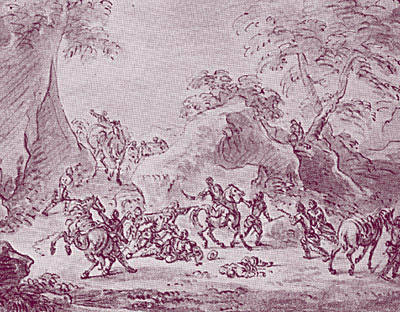| Snaphanerne

| | Den Skånske Krig blev en katastrofe for Skåne med omfattende ødelæggelser og tab af mange menneskeliv. Brutaliteten i krigsførelsen blev ikke mindre af, at krigen delvist blev ført som en partisankrig. Bl.a. af de såkaldte Snaphaner. |
Partisaner og friskytter
Den forfærdelige ødelæggelse som ramte Skåne i forbindelse med Skånske Krig blev ikke mindre af at krigen delvis førtes som partisankrig.Lokale bondeopbud, ofte med støtte af danskere, gennemførte baghold, kup og andre angreb mod svenskerne. Det lykkedes således et opbud af göingar at erobre den svenske krigskasse ved et kup i Loshult lige syd for grænsen til Småland. Samarbejde med smålandske bønder kan ikke udelukkes og værdien af det erobrede beløb sig til omkring 50.000 rigsdaler.
Selv såkaldte friskyttekorps med en rent militær organisation deltog i denne guerillakrig. Mange fattige bønder, men også soldater lod sig hverve som danske friskytter og indgik da som en del af den danske krigsorganisation. Sådanne grupper var virksomme over hele Skåne og der fandtes også fattige eventyrere og andre, deriblandt kriminelle, som nærmest førte deres egen krig i skovene i det nordlige Skåne på grænsen til Småland.

Skånske partisaner | 
Overfald | 
Snaphanekontrakt | 
Skåne 1677 | 
Skåne 1662 |
Begrebet Snaphane
Alle disse som indgik i bondeopbud, friskyttekompagnier og røverbander gik under betegnelsen ”Snaphaner”. Ordet kommer måske af det tyske ”schnappen”, som betyder at røve. I så fald indebar betegnelsen snaphane noget negativt og udtrykket skulle i så fald allerede fra starten have en vis negativ betydning, således at alle der fald indenfor betegnelsen skulle opfattes som røvere.
Grænseland og bondefred
Befolkningen i grænseområdet var, som altid i krig, særligt udsatte. Urgammelt samarbejde over grænsen modarbejdedes og at den svenske stat havde øget skatterne i disse områder skabte misfornøjelse. Bønder på begge sider som ikke tidligere havde brudt sig om nationale grænser sluttede såkaldt bondefred og demonstrerede dermed selvstændighed imod de nationale krav, som centralmagten førte frem. En sådan fred sluttedes f.eks. imellem Osby i Skåne og Virestad i Småland i 1676.
Undertiden benævnes Skånske Krig ligefrem Snaphanekrigen. Den eventyrlighed som præger partisankrig har givetvis næret fantasien, og de mange historier, ofte med romantiske og heroiske indslag, som eftertiden beretter om, skal nok tages med et gran salt. Snaphanerne og frem for alt deres lederes store betydning kan der dog ikke stilles spørgsmålstegn ved, hvilket reaktionerne på dem tydeligt viser.
Grusomme straffe
De hårde og grumme straffe somsnaphanerne idømtes, er bevis på at svenskerne blev alvorligt forstyrret af disse angreb, som forvoldte store skade for den svenske centraladministration og forsinkede uniformitetsarbejdet. Skånske bønder i nogle byer blev kollektivt afstraffet, fordi nogen af dem var blevet snaphaner. Der blev også vedtaget bestemmelser imod bønder som på en eller anden måde mistænktes for at pleje omgang med snaphanerne. Grumheder findes der masser af beretninger og vidnesbyrdom.
I foråret 1677 afkrævede svenskerne beboerne i Skåne loyalitetserklæringer og i april 1678 gav kongen befaling til at afbrænde alle gårde og dræbe alle våbenføre mænd i Ørkned Sogn i det nordøstlige Gønge Herred.

Sporekullagården | 
Gård fra 1600-tallet | 
Snaphanestatue |
Skånske flygtninge
I sommeren 1679, da Skånske Krig lakkede mod enden, opfordrede den danske konge igen skåningerne til at flygte til Sjælland og lokkede med tilsagn om 20 års skattefrihed. Hvor mange der tog imod dette tilbud er der delte meninger om, men 10.000 eller flere er nok ikke helt forkert og et ikke ubetydeligt antal efter datidens målestok. En del var flygtet allerede under krigen og flere kommer til ved soldaterudskrivningen i Skåne 1680. Erfaringerne viste at de unge skånske mænd blev deporteret til fjernliggende områder i Balticum og ofte ikke vendte tilbage igen.
De skåninger og andre der flygtede havnede fortrinsvis på Sjælland og Amager, hvor en del kunne overtage fæstegårde mens andre sikkert har fristet en mere kummerlig tilværelse og der var i lighed med den forrige krig også folk der vendte tilbage til Skåne igen. Forholdet imellem de landflygtige og fastboende har så vidt det kan skønnes været godt og en række danske byer, f.eks. København, Dragør og Helsingør fik ved den lejlighed et tiltrængt befolkningstilskud.
Bevægelsen dør ud
Samtidig med at mange blev skræmte af de hårde straffe, blev en del bønder trætte af de endeløse plyndringer og hærgninger der fandt sted, og et modsætningsforhold imellem snaphanerne og en del skånske bønder opstod. Dette førte til at snaphanernes antal sagte, men sikkert reduceredes og ved danskernes genkomst i sammenhæng med Store nordiske Krig i 1710, var snaphanebevægelsen uden større betydning.
Snaphanebevægelsens omfang, karakter og betydning diskuteres stadigvæk blandt historikere og lægmænd på begge sider af Øresund. |